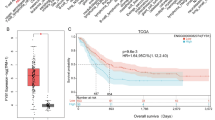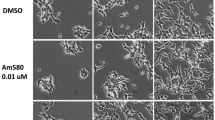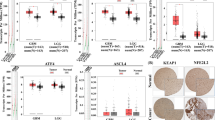Abstract
CD56 is frequently detected on primary myeloma cells from more than 80% patients with overt myeloma. In order to clarify the possible mechanisms of CD56 expression in human myeloma, we underwent screening for potential targets by microarray analysis, where the CD56(+) myeloma cell lines showed markedly increased expressions of transcription factors involved in the neuronal cell lineage compared to the CD56(−) myeloma cell lines. Here, we show that among the SOX family of transcription factors, SOX4 was highly up-regulated and SOX1 was down-regulated in the CD56(+) myeloma cell lines as well as in primary myeloma cases as confirmed by the RT-PCR. ChIP analysis of the CD56 promoter region showed specific bindings of SOX4 in the CD56(+) and SOX1 in the CD56(−) myeloma cell lines, respectively. shRNA against SOX1 failed to induce CD56 expression in CD56(−) myeloma cell line, U266. On the contrary, over-expression of SOX4 in the CD56(−) myeloma cell line could induce the CD56 expression. Silencing of SOX4 by shRNA transfection down-regulated CD56 expression and induced apoptosis to CD56(+) human myeloma cell line, AMO1. Thus, induction of SOX4 gene expression might be responsible for the CD56 expression in human myeloma cells.





Similar content being viewed by others
References
Liu S, Otsuyama K, Ma Z, et al. Induction of multilineage markers in humna myeloma cells and their down-regulation by interleukin 6. Int J Hematol. 2007;85:49–58.
Ruiz-Arguelles GJ, San Miguel JF. Cell surface markers in multiple myeloma. Mayo Clin Proc. 1994;69:684–90.
Huff CA, Matsui W. Multiple myeloma cancer stem cells. J Clin Oncol. 2008;26(17):2895–900.
Greef CD, Riet IV, Bakkus M, Camp BV. Differential gene expression of the neural cell adhesion molecule (N-CAM) in a panel of myeloma cell lines. Leukemia. 1998;12:86–93.
Zecchini S, Cavallaro U. Neural cell adhesion molecule in cancer: expression and mechanisms. Neurochem Res. 2008. doi:10.1007/s11064-008-9597-9.
Edelman GM, Crossin KL. Cell adhesion molecules: Implication for a molecular histology. Annu Rev Biochem. 1991;60:155–90.
Mendez ALP. Critical roles of SoxC transcription factors in development and cancer. Int J Biochem Cell Biol. 2009. doi:10.1016/j.biocel.2009.07.018.
van de Wetering M, Oosterwegel M, van Norren K, Clevers H. Sox-4, an sry-like hmg box protein, is a transcriptional activator in lymphocytes. EMBO J. 1993;12:3847–54.
Schilham MW, Moerer P, Cumano A, Clevers HC. Sox-4 facilitates thymocyte differentiation. Eur J Immunol. 1997;27:1292–5.
Cheung M, Abu-Elmagd M, Clevers H, Scotting PJ. Roles of sox4 in central nervous system development. Brain Res Mol Brain Res. 2000;79:180–91.
Schilham MW, et al. Defects in cardiac outflow tract formation and pro-blymphocyte expansion in mice lacking sox-4. Nature. 1996;380:711–4.
Pan X, Zhao J, Zhang WN, et al. Induction of SOX4 by DNA damage is critical for p53 stabilization and function. Proc Natl Acad Sci USA. 2009;106(10):3788–93.
Shimizu S, Yoshioka R, Hirose Y, Sugai S, Tachibana J, Konda S. Establishment of two interleukin 6 (B cell stimulatory factor 2/interferon beta 2)-dependent human bone marrow-derived myeloma cell lines. J Exp Med. 1989;169:339–44.
Nagai T, Ogura M, Morishita Y, et al. Establishment and characterization of a new human Bence Jones-type myeloma cell line, NOP-2. Int J Hematol. 1991;54:141–9.
Shimizu S, Takiguchi T, Fukutoku M, et al. Establishment of a CD4-positive plasmacytoma cell line (AMO1). Leukemia. 1993;7:274–80.
Li FJ, Tsuyama N, Ishikawa H, et al. A rapid translocation of CD45RO but not CD45RA to lipid rafts in IL-6-induced proliferation in myeloma. Blood. 2005;105:3295–302.
Iqbal MS, Otsuyama K, Shamsasenjan K, et al. Constitutively lower expressions of CD54 on primary myeloma cells and their different localizations in bone marrow. Eur J Haematol. 2009;83(4):302–12.
Shamsasenjan K, Otsuyama K, Abroun S, et al. Il-6-induced activation of MYC is responsible for the down-regulation of CD33 expression in CD33(+) myeloma cells. Int J Hematol. 2009;89:310–8.
Bergsland M, Werme M, Malewicz M, et al. The establishment of neuronal properties is controlled by SOX4 and SOX11. Genes Dev. 2006;20(24):3475–86.
Bylund M, Andersson E, Novitch BG, Muhr J. Vertebrate neurogenesis is counteracted by SOX1-3 activity. Nat Neurosci. 2003;6(11):1162–8.
Burton CH, Mann DA, Walsh FH. Characterization of the human N-CAM promoter. Biochem J. 1990;268:161–8.
Wegner M. All purpose Sox: The many roles of Sox proteins in gene expression. Int J Biochem Cell Biol. 2009. doi:10.1016/j.biocel.2009.07.006.
Svingen T, Toniseen KF. Hox transcription factors and their elusive mammalian gene targets. Heredity. 2006;97:88–96.
Di Rocco G, Gavalas A, Popperl H, et al. The recruitment of SOX/OCT complexes and the differential activity of HOXA1 and HOXB1 modulate the Hoxb1 auto-regulatory enhancer function. J Biol Chem. 2001;276:20506–15.
Akin ZN, Nazarali AJ. Hox genes and their candidate downstream targets in the developing central nervous system. Cell Mol Neurobiol. 2005;25(3–4);697–741.
Acknowledgments
This work was supported in part by grants from the Japanese Ministry of Education, Science, Sports and Culture of Japan, and the Ministry of Health, Labour and Welfare of Japan.
Author information
Authors and Affiliations
Corresponding author
About this article
Cite this article
Iqbal, M.S., Otsuyama, Ki., Shamsasenjan, K. et al. CD56 expression in human myeloma cells derived from the neurogenic gene expression: possible role of the SRY-HMG box gene, SOX4 . Int J Hematol 91, 267–275 (2010). https://doi.org/10.1007/s12185-009-0474-3
Received:
Revised:
Accepted:
Published:
Issue Date:
DOI: https://doi.org/10.1007/s12185-009-0474-3




